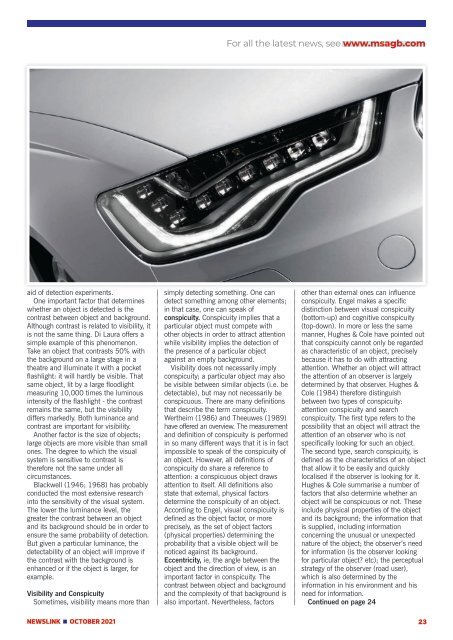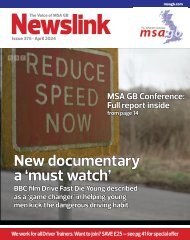Newslink October 2021
Membership magazine of the Motor Schools Association; road safety, driver training and testing news.
Membership magazine of the Motor Schools Association; road safety, driver training and testing news.
Create successful ePaper yourself
Turn your PDF publications into a flip-book with our unique Google optimized e-Paper software.
For all the latest news, see www.msagb.com<br />
aid of detection experiments.<br />
One important factor that determines<br />
whether an object is detected is the<br />
contrast between object and background.<br />
Although contrast is related to visibility, it<br />
is not the same thing. Di Laura offers a<br />
simple example of this phenomenon.<br />
Take an object that contrasts 50% with<br />
the background on a large stage in a<br />
theatre and illuminate it with a pocket<br />
flashlight: it will hardly be visible. That<br />
same object, lit by a large floodlight<br />
measuring 10,000 times the luminous<br />
intensity of the flashlight - the contrast<br />
remains the same, but the visibility<br />
differs markedly. Both luminance and<br />
contrast are important for visibility.<br />
Another factor is the size of objects;<br />
large objects are more visible than small<br />
ones. The degree to which the visual<br />
system is sensitive to contrast is<br />
therefore not the same under all<br />
circumstances.<br />
Blackwell (1946; 1968) has probably<br />
conducted the most extensive research<br />
into the sensitivity of the visual system.<br />
The lower the luminance level, the<br />
greater the contrast between an object<br />
and its background should be in order to<br />
ensure the same probability of detection.<br />
But given a particular luminance, the<br />
detectability of an object will improve if<br />
the contrast with the background is<br />
enhanced or if the object is larger, for<br />
example.<br />
Visibility and Conspicuity<br />
Sometimes, visibility means more than<br />
simply detecting something. One can<br />
detect something among other elements;<br />
in that case, one can speak of<br />
conspicuity. Conspicuity implies that a<br />
particular object must compete with<br />
other objects in order to attract attention<br />
while visibility implies the detection of<br />
the presence of a particular object<br />
against an empty background.<br />
Visibility does not necessarily imply<br />
conspicuity; a particular object may also<br />
be visible between similar objects (i.e. be<br />
detectable), but may not necessarily be<br />
conspicuous. There are many definitions<br />
that describe the term conspicuity.<br />
Wertheim (1986) and Theeuwes (1989)<br />
have offered an overview. The measurement<br />
and definition of conspicuity is performed<br />
in so many different ways that it is in fact<br />
impossible to speak of the conspicuity of<br />
an object. However, all definitions of<br />
conspicuity do share a reference to<br />
attention: a conspicuous object draws<br />
attention to itself. All definitions also<br />
state that external, physical factors<br />
determine the conspicuity of an object.<br />
According to Engel, visual conspicuity is<br />
defined as the object factor, or more<br />
precisely, as the set of object factors<br />
(physical properties) determining the<br />
probability that a visible object will be<br />
noticed against its background.<br />
Eccentricity, ie, the angle between the<br />
object and the direction of view, is an<br />
important factor in conspicuity. The<br />
contrast between object and background<br />
and the complexity of that background is<br />
also important. Nevertheless, factors<br />
other than external ones can influence<br />
conspicuity. Engel makes a specific<br />
distinction between visual conspicuity<br />
(bottom-up) and cognitive conspicuity<br />
(top-down). In more or less the same<br />
manner, Hughes & Cole have pointed out<br />
that conspicuity cannot only be regarded<br />
as characteristic of an object, precisely<br />
because it has to do with attracting<br />
attention. Whether an object will attract<br />
the attention of an observer is largely<br />
determined by that observer. Hughes &<br />
Cole (1984) therefore distinguish<br />
between two types of conspicuity:<br />
attention conspicuity and search<br />
conspicuity. The first type refers to the<br />
possibility that an object will attract the<br />
attention of an observer who is not<br />
specifically looking for such an object.<br />
The second type, search conspicuity, is<br />
defined as the characteristics of an object<br />
that allow it to be easily and quickly<br />
localised if the observer is looking for it.<br />
Hughes & Cole summarise a number of<br />
factors that also determine whether an<br />
object will be conspicuous or not. These<br />
include physical properties of the object<br />
and its background; the information that<br />
is supplied, including information<br />
concerning the unusual or unexpected<br />
nature of the object; the observer’s need<br />
for information (is the observer looking<br />
for particular object? etc); the perceptual<br />
strategy of the observer (road user),<br />
which is also determined by the<br />
information in his environment and his<br />
need for information.<br />
Continued on page 24<br />
NEWSLINK n OCTOBER <strong>2021</strong><br />
23

















